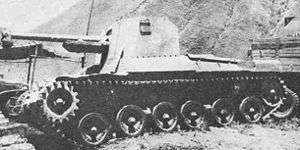Type 1 Ho-Ni I
The Type 1 Gun tank Ho-Ni I (一式砲戦車 ホニ I, Isshiki ho-sensha Ho-Ni I) was a tank destroyer and self-propelled artillery developed by the Imperial Japanese Army for use during World War II in the Pacific theater.
| Type 1 Ho-Ni I | |
|---|---|
 Type 1 Ho-Ni I tank destroyer | |
| Type | Tank destroyer |
| Place of origin | Empire of Japan |
| Production history | |
| Produced | 1942 |
| No. built | 26 of Type I and 54 of Type II[1] |
| Specifications | |
| Mass | 15.4 tons |
| Length | 5.9 m (19 ft 4 in) |
| Width | 2.29 m (7 ft 6 in) |
| Height | 2.39 m (7 ft 10 in) |
| Crew | 5 |
| Armor | 25–51 mm |
Main armament | 75mm Type 90 gun |
| Engine | Mitsubishi SA12200VD air-cooled V-12 diesel (21.7 litres) 170 hp at 2000 rpm |
| Power/weight | 11.0 hp/t |
| Suspension | bell-crank |
Operational range | 200 km (120 mi) |
| Maximum speed | 38 km/h (24 mph) |
History and development
The Type 1 Ho-Ni I was the first self-propelled gun design of this particular type.[2] They were meant to be self-propelled artillery and tank destroyers for armored divisions.[3][4] The plan was for the Type 1 Ho-Ni I gun tank to form part of a fire support company in each of the tank regiments.[4] The first conversion took place in June, 1941. Production of the Type 1 Ho-Ni I took place during 1942. The total number of Type 1 Ho-Ni I units produced was only 26.[5]
The Type 1 Ho-Ni I was developed by using the existing Type 97 chassis and engine, and replacing the gun turret with a 75 mm Type 90 Field Gun mounted in an open casemate with frontal and side armour only.[5] The gun mounting gave ten degrees of traverse and -5 to +25 degrees of elevation; it could also traverse 20 degrees to either side, so the entire vehicle did not have to be turned.[3] The Type 1 Ho-Ni I carried 54 rounds of ammunition.[6]
They were designed to operate as self-propelled artillery at ranges of up to 12,000 metres (7.5 mi).[5][6] The design had no provision for a defensive machine gun, which together with the open structure made it vulnerable in close combat.[6]
The Type 97 chassis, suspension and diesel engine were used unchanged.[3] The 75 mm Type 90 Field Gun, was protected on three sides by 51 mm thick armored plate. The hull armored plate was 25 mm on the sides and 20 mm on the rear.[7]
Variants
The Type 1 Ho-Ni II was one variant. It mounted a Type 91 105 mm howitzer and had a slightly changed superstructure as far as the side armor with re-positioned observation visors.[8] A prototype was built in July, 1942. Production of the Type 1 Ho-Ni II did not begin until 1943. A total of 54 units were produced.[5]
The other variant was the Type 3 Ho-Ni III, which mounted a Type 3 75 mm tank gun in a completely enclosed armored casemate to address the issue of crew protection in close combat. A total of 31 were produced.[5][9][10]
Combat history
The Type 1 Ho-Ni I was first deployed in combat at the Battle of Luzon in the Philippines in 1945, but like the rest of the Japanese armor of the 2nd Tank Division, they were defeated in action against superior US Army forces.[11][12] In addition, the Type 1 Ho-Ni were not available in sufficient numbers to make an impact on the Battle of the Philippines. Type 1 Ho-Ni were also used by the Japanese Army in Burma, late in the war.[13]
The Type 1 Ho-Ni I was produced in small quantities in 1942, when it was superseded by the Type 1 Ho-Ni II and then the Type 3 Ho-Ni III.[14] The total number produced of all three types in the Ho-Ni series were 111 units.[5] Most of the Ho-Ni units were retained within the Japanese home islands to form part of the defenses against the projected American invasion, and did not see combat before the surrender of Japan.[15]
Survivors
A Type 1 Ho-Ni I from the IJA 2nd Tank Division, 2nd Armored Artillery Regiment was captured by the US Army 37th Infantry Division on Luzon on April 6, 1945 as is currently at the United States Army Depot, Anniston, AL.
Notes
- Zaloga 2007, p. 17.
- Tomczyk 2007, p. 15.
- Tomczyk 2007, p. 3.
- Zaloga 2012, p. 34.
- Zaloga 2007, p. 19.
- History of War: "Type 1 Ho-Ni I Self-Propelled Gun"
- Tomczyk 2007, p. 8.
- Tomczyk 2007, pp. 10, 20.
- Tomczyk 2005, p. 3.
- Tomczyk 2007, p. 27.
- Zaloga 2007, pp. 37–39.
- Rottman & Takizawa 2008, pp. 53, 55.
- Taki's Imperial Japanese Army: Type 1 "Ho-Ni" I
- Tomczyk 2007, pp. 9, 10.
- Zaloga 2007, pp. 19, 20.
References
- Rottman, Gordon L.; Takizawa, Akira (2008). World War II Japanese Tank Tactics. Osprey Publishing. ISBN 978-1846032349.CS1 maint: ref=harv (link)
- Tomczyk, Andrzej (2005). Japanese Armor Vol. 4. AJ Press. ISBN 978-8372371676.CS1 maint: ref=harv (link)
- Tomczyk, Andrzej (2007). Japanese Armor Vol. 5. AJ Press. ISBN 978-8372371799.CS1 maint: ref=harv (link)
- Zaloga, Steven J. (2007). Japanese Tanks 1939–45. Osprey. ISBN 978-1-8460-3091-8.CS1 maint: ref=harv (link)
- Zaloga, Steven J. (2012). M4 Sherman vs Type 97 Chi-Ha: The Pacific 1945. Osprey Publishing. ISBN 978-1849086387.CS1 maint: ref=harv (link)
Further reading
- Foss, Christopher (2003). Great Book of Tanks: The World's Most Important Tanks from World War I to the Present Day. Zenith Press. ISBN 0-7603-1475-6.
- Foss, Christopher (2003). Tanks: The 500. Crestline. ISBN 0-7603-1500-0.